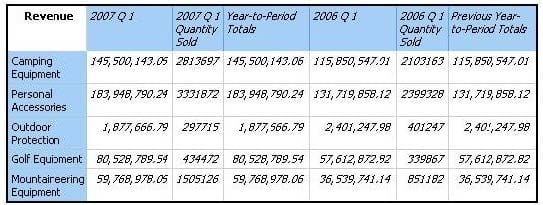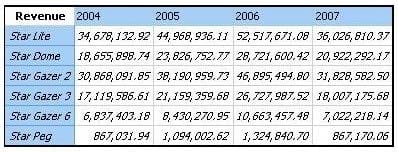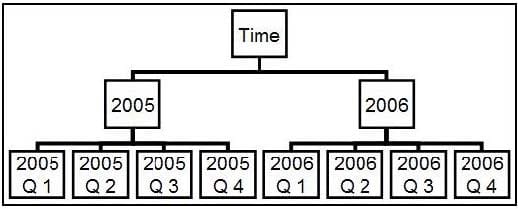C2090-645 Online Practice Questions and Answers
In a crosstab, Campaign is in the rows area, Order method type is in the columns area, and Quantity is the measure. Campaign and Order method type are specified in the query. The report runs, displaying quantity valuesfor all years.
Why does this happen?
A. The dimension member from that dimension is implied.
B. The order method member from that dimension is implied.
C. The aggregate member from that dimension is implied.
D. The default member from that dimensionis implied.
What is true about MUNs?
A. A MUN is abusiness key that allows drill through between packages.
B. A MUN is a key with a unique value at each level.
C. A MUN contains the fully qualified path to a member.
D. A MUN is a category code that is generated when the cube is built.
A report author uses the following expression: lastPeriods(3,[2007/Mar]). What data will be returned when the report is run?
A. The last 3 months before 2007/Mar
B. 3 months, including 2007/Mar and the preceeding 2 months
C. The total of currentMeasure for 3 months including 2007/Mar and the preceeding 2 months
D. The month March of each of the 3 years 2005, 2006, and 2007
The following expression is used to focus OLAP data in the rows of a report: filter([sales_and_marketing].[Order method].[Order method].[Order method type], [Revenue]>150000000).

Which of the following statements describes the purpose of the expression?
A. To return the set of members whose revenue is less than150000000 for any year.
B. To return the set of members whose revenue is greater than 150000000 for the sum of the opposite edge.
C. To filter the cell values by subtracting 150000000 from the revenue for each year and order method type.
D. To filter the years to show those having revenues greater than 150000000 by order method type.
Consumers want a report to compare the revenue and quantity sold for all product lines in a selected quarter, to the same quarter for the previousyear. They also want to see the total for periods, up to and including the quarter selected.

Which of the following dimensional functions could the report author use to create this report?
A. Ancestor, currentMember, lead, total
B. OpeningPeriod, order, quarter, Firstsibling
C. Cousin, tuple, closingPeriod, aggregate
D. ParallelPeriod, tuple, periodsToDate, aggregate
What does the following expression do:
"generate([Productline],topCount(descendants(currentMember([sales_and_marketing].[Pro ducts].[Products]),[sales_and_marketing].[Products].[Products].[Product]),2,[Revenue]))"?
A. Returns the top two products by revenue for each product line.
B. Finds the top two members by revenue at the product level and returns their respective ancestors at the product line level.
C. Calculates the top two product lines for each product.
D. Goes two levels up from products and returns the top members by revenue at that level.
In a crosstab report, the report author wants a column to display a percentage of overall revenue that a particular product contributed to.

Which of the following is a valid dimensional expression forthis purpose?
A. tuple([Revenue]/[Products]*[Revenue])
B. [Revenue]/([Revenue]*[Products])
C. [Revenue]/tuple([Revenue],[Products])
D. [Revenue]/total([Revenue]for[Products])
A report author creates an expression usingthe closingPeriod function to return the latest month found in the data source, and names the expression "Current Month".
What can the report author do with "Current Month"?
A. Use it to replace the lastPeriods(1,[Month]) expression currently in the report.
B. Add it to an expression to find the current member for the Month level.
C. Use it to determine the current quarter: parent([Current Month]).
D. Use it as a report expression to display the current month in the page header of the report.
Which of the following statements is correct about the order function?
A. The currentMeasure function must be used with the orderfunction as the sort by criterion.
B. It arranges members of all sets in the report by ascending or descending values.
C. Optional parameters allow the author to order the members of a hierarchy without regard of their level.
D. It arranges members of a set alphabetically by ascending or descending captions.
Instead of prompting the user to select any countries in Europe, the report author wants to constrain the user to select one or more countries from the Northern Europe region. What kind of prompt should be used and how can this be achieved?
A. This is not possible because a prompt must always be populated with all members of a level.
B. Create a multi-select value prompt. Populate it using an expression on the [Northern Europe] member to retrieve its children on the country level.
C. Generate a prompt by creating an expression with a parameter on the crosstab edge: children([Northern Europe]->?Country?
D. Create a tree prompt, and populate it using an expression on the[Northern Europe] member to retrieve its children at the country level.
Based on the diagram,

if the expression firstSibling([2006 Q 1]) is used in the report, what item will be returned?
A. 2005 Q 1
B. 2006 Q 4
C. 2006 Q 1
D. Nothing, because the return value equals the parameter
Why would a report author consider overriding the default drill behavior?
A. To maintain the behavior of a complex edge expression after drilling, such as one which returns the top 5 members of a set.
B. To replace all members within a hierarchy when drilling through to a report with more detail.
C. To drill down to the lowest level of the hierarchy and then drill down again to display only one member.
D. To drill down on a member and have its children display as details and have the member drilled on display as summary.
The report author wants tocreate a report to compare the sales of product types for special sales promotions in 2005 and 2006, but the report will exclude regular sales.
Which style of authoring and which function will the report author use to create this report from a cube data source?
A. Relational authoring style, except function
B. Dimensional authoring style, filter function
C. Dimensional authoring style, except function
D. Relational authoring style, filter function
A report author creates a revenue report from an OLAP data source. On the rows, there are nested levels, each from different dimensions having a large number of members. The report author filters out empty rows using the expression "[Revenue] > 0".
When running this report, there is poor performance. What could cause this?
A. There are too many members or levels nested on the rowedge.
B. Filtering on measure values is incompatible with an OLAP data source.
C. Limiting the crosstab measures with a filter function.
D. A relational filter was applied.
To display all individual campaigns in a crosstabreport, a report author could use the expression set([TrailChef Campaign],[EverGlow Campaign],[Course Pro Campaign]). Instead, the report author decides to use the parent member of the campaigns in the set expression "children([All Campaigns])".
Which statement is true about the method that was used?
A. In the future, when a campaign is deleted or new ones are added, the report author must modify the expression.
B. In the future, when a campaign is deleted or new ones are added, the unmodified expression will be valid.
C. The report author should not have used the method chosen, as the first method is best in this situation.
D. To be accurate, the report author should avoid using a set expression.
